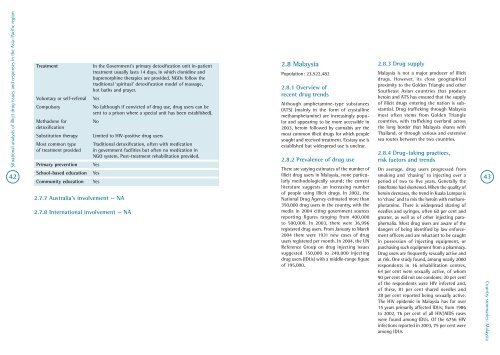Illicit Drug use in the Asia Pacific Region - Burnet Institute
Illicit Drug use in the Asia Pacific Region - Burnet Institute
Illicit Drug use in the Asia Pacific Region - Burnet Institute
You also want an ePaper? Increase the reach of your titles
YUMPU automatically turns print PDFs into web optimized ePapers that Google loves.
Situational analysis of illicit drug issues and responses <strong>in</strong> <strong>the</strong> <strong>Asia</strong>–<strong>Pacific</strong> region<br />
42<br />
Treatment In <strong>the</strong> Government’s primary detoxification unit <strong>in</strong>-patient<br />
treatment usually lasts 14 days, <strong>in</strong> which clonid<strong>in</strong>e and<br />
buprenorph<strong>in</strong>e <strong>the</strong>rapies are provided . NGOs follow <strong>the</strong><br />
traditional ‘spiritual’ detoxification model of massage,<br />
hot baths and prayer .<br />
Voluntary or self-referral Yes<br />
Compulsory No (although if convicted of drug <strong>use</strong>, drug <strong>use</strong>rs can be<br />
sent to a prison where a special unit has been established) .<br />
Methadone for<br />
No<br />
detoxification<br />
Substitution <strong>the</strong>rapy Limited to HIV-positive drug <strong>use</strong>rs<br />
Most common type<br />
of treatment provided<br />
Primary prevention Yes<br />
School-based education Yes<br />
Community education Yes<br />
2 .7 .7 Australia’s <strong>in</strong>volvement — NA<br />
2 .7 .8 International <strong>in</strong>volvement — NA<br />
Traditional detoxification, often with medication<br />
<strong>in</strong> government facilities but often no medication <strong>in</strong><br />
NGO system . Post-treatment rehabilitation provided .<br />
2 .8 Malaysia<br />
Population: 23,522,482<br />
2 .8 .1 Overview of<br />
recent drug trends<br />
Although amphetam<strong>in</strong>e-type substances<br />
(ATS) (ma<strong>in</strong>ly <strong>in</strong> <strong>the</strong> form of crystall<strong>in</strong>e<br />
methamphetam<strong>in</strong>e) are <strong>in</strong>creas<strong>in</strong>gly popular<br />
and appear<strong>in</strong>g to be more accessible <strong>in</strong><br />
2003, hero<strong>in</strong> followed by cannabis are <strong>the</strong><br />
most common illicit drugs for which people<br />
sought and received treatment . Ecstasy <strong>use</strong> is<br />
established but widespread <strong>use</strong> is unclear .<br />
2 .8 .2 Prevalence of drug <strong>use</strong><br />
There are vary<strong>in</strong>g estimates of <strong>the</strong> number of<br />
illicit drug <strong>use</strong>rs <strong>in</strong> Malaysia, none particularly<br />
methodologically sound; <strong>the</strong> current<br />
literature suggests an <strong>in</strong>creas<strong>in</strong>g number<br />
of people us<strong>in</strong>g illicit drugs . In 2002, <strong>the</strong><br />
National <strong>Drug</strong> Agency estimated more than<br />
350,000 drug <strong>use</strong>rs <strong>in</strong> <strong>the</strong> country, with <strong>the</strong><br />
media <strong>in</strong> 2004 cit<strong>in</strong>g government sources<br />
report<strong>in</strong>g figures rang<strong>in</strong>g from 400,000<br />
to 500,000 . In 2003, <strong>the</strong>re were 36,996<br />
registered drug <strong>use</strong>rs . From January to March<br />
2004 <strong>the</strong>re were 1931 new cases of drug<br />
<strong>use</strong>rs registered per month . In 2004, <strong>the</strong> UN<br />
Reference Group on drug <strong>in</strong>ject<strong>in</strong>g issues<br />
suggested 150,000 to 240,000 <strong>in</strong>ject<strong>in</strong>g<br />
drug <strong>use</strong>rs (IDUs) with a middle-range figure<br />
of 195,000 .<br />
2 .8 .3 <strong>Drug</strong> supply<br />
Malaysia is not a major producer of illicit<br />
drugs . However, its close geographical<br />
proximity to <strong>the</strong> Golden Triangle and o<strong>the</strong>r<br />
Sou<strong>the</strong>ast <strong>Asia</strong>n countries that produce<br />
hero<strong>in</strong> and ATS has ensured that <strong>the</strong> supply<br />
of illicit drugs enter<strong>in</strong>g <strong>the</strong> nation is substantial<br />
. <strong>Drug</strong> traffick<strong>in</strong>g through Malaysia<br />
most often stems from Golden Triangle<br />
countries, with traffick<strong>in</strong>g overland across<br />
<strong>the</strong> long border that Malaysia shares with<br />
Thailand, or through various and extensive<br />
sea routes between <strong>the</strong> two countries .<br />
2 .8 .4 <strong>Drug</strong>-tak<strong>in</strong>g practices,<br />
risk factors and trends<br />
On average, drug <strong>use</strong>rs progressed from<br />
smok<strong>in</strong>g and ‘chas<strong>in</strong>g’ to <strong>in</strong>ject<strong>in</strong>g over a<br />
period of two to five years . Generally <strong>the</strong><br />
timeframe had shortened . When <strong>the</strong> quality of<br />
hero<strong>in</strong> decreases, <strong>the</strong> trend <strong>in</strong> Kuala Lumpur is<br />
to ‘chase’ and to mix <strong>the</strong> hero<strong>in</strong> with methamphetam<strong>in</strong>e<br />
. There is widespread shar<strong>in</strong>g of<br />
needles and syr<strong>in</strong>ges, often 60 per cent and<br />
greater, as well as of o<strong>the</strong>r <strong>in</strong>ject<strong>in</strong>g paraphernalia<br />
. Most drug <strong>use</strong>rs are aware of <strong>the</strong><br />
dangers of be<strong>in</strong>g identified by law enforcement<br />
officers and are reluctant to be caught<br />
<strong>in</strong> possession of <strong>in</strong>ject<strong>in</strong>g equipment, or<br />
purchas<strong>in</strong>g such equipment from a pharmacy .<br />
<strong>Drug</strong> <strong>use</strong>rs are frequently sexually active and<br />
at risk . One study found, among nearly 2000<br />
respondents <strong>in</strong> 16 rehabilitation centres,<br />
64 per cent were sexually active, of whom<br />
90 per cent did not <strong>use</strong> condoms; 20 per cent<br />
of <strong>the</strong> respondents were HIV <strong>in</strong>fected and,<br />
of <strong>the</strong>se, 81 per cent shared needles and<br />
28 per cent reported be<strong>in</strong>g sexually active .<br />
The HIV epidemic <strong>in</strong> Malaysia has for over<br />
15 years primarily affected IDUs; from 1986<br />
to 2002, 76 per cent of all HIV/AIDS cases<br />
were found among IDUs . Of <strong>the</strong> 6756 HIV<br />
<strong>in</strong>fections reported <strong>in</strong> 2003, 75 per cent were<br />
among IDUs .<br />
43<br />
Country summaries: Malaysia









